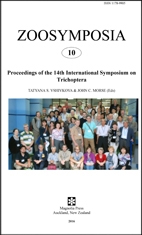Abstract
Many foreign and indigenous scientists have contributed extensively to our knowledge of Asian caddisflies. At the time of the Trichoptera Symposium in 2012, the number (1,090 spp.) and density (43 spp./Gm2) of Trichoptera species in the East Palearctic Region were the least for any of the Earth’s 7 biogeographic regions as defined by the Trichoptera World Checklist; the number (5,313 spp.) and density (405 spp./Gm2) in the Oriental Region were the greatest. Limnephilidae, Rhyacophilidae, and Leptoceridae are the most speciose families in the East Palearctic Region; Leptoceridae, Hydropsychidae, and Hydroptilidae in the Oriental Region. In the East Palearctic Region, 288 fossil species have been reported, most of which are ichnotaxa, sedimentary impressions of larval cases for which the family is unknown; in the Oriental Region, only two fossil species are known, both from Burmese amber. Based on cosmopolitan species, the distinction between the East Palearctic and Oriental Regions is as great or greater than average; the distinction between the East and West Palearctic Regions is less than average but between the East Palearctic and the Nearctic Region is greater; the fauna of the Oriental Region is conspicuously endemic. Future increases in knowledge of the Asia Trichoptera fauna will result from accelerated collecting in poorly explored regions; increasing the rate of identifying and describing new and poorly known species, especially with use of modern molecular, computational, and networking tools and especially focusing on descriptions of larvae in the Oriental Region; mentoring young Asian Trichoptera scientists for excellence in research quality and productivity; and promoting international collaborations for theoretical and applied science in Asia.
References
BOLDSystems. (2013) Barcode of life database systems. Available from: http://www.barcodinglife.com/ (accessed 18 February 2013)
Botosaneanu, L. (1981) On a false and a genuine caddis-fly from Burmese amber (Insecta: Trichoptera, Homoptera). Bulletin Zoologisch Museum, Universiteit van Amsterdam, 8 (10), 73–78.
Dudgeon, D. (1999) Tropical Asian streams: Zoobenthos, ecology and conservation. Hong Kong University Press, Hong Kong, 830 pp.
Fabricius, J.C. (1781) Species insectorum exhibentes eorum differentias specificas, synonyma auctorum, loca natalia, metamorphosia adjectis observationibus, descriptionibus. Vol. I & II. impensis C. E. Bohnii, Hamburgi et Kilonii, 552 & 494 pp.
Gmelin, J.F. (1789) Caroli a Linné systema naturae per regna tria naturae, secundum classes, ordines, genera, species, cum characteribus, differentiis, synonymis, locis. Editio decima tertia, aucta, reformata. Tomus I. Pars V. Georg Emanuel Beer, Leipzig, pp. 2225–3020.
Hagen, H.A. (1858) Russlands neuropteran. Stettiner Entomologische Zeitung, 19, 110–134.
Iwata, M. (1928) Five new species of trichopterous larvae from Formosa. Annotationes Zoologicae Japonenses, 11(4), 341–351.
Kawai, T., & Tanida, K. (Eds.) (2005) Aquatic insects of Japan: Manual with keys and illustrations. Tokai University Press, Kanagawa, 1342 pp. [in Japanese]
Linnaeus, C. (1758) Systema naturae per regna tira naturae, secundum classes, ordines, genera, species, cum characteribus, differentiis, synonymis, locis, ed. decima reformata. 1, Animalia. Laurentii Salvii, Stockholm, 823 pp.
Malicky, H. (1970) Die Präimaginalstadien von Limnocentropus grandis [sic] Banks (Trichoptera: Limnocentropodidae). Entomologische Berichten, 30, 159–164.
Malicky, H. (1987) On some Rhyacophila from Doi Suthep Mountain, northern Thailand. Trichoptera Newsletter (Lunz, Austria), 14, 27–29.
Matsumura, M. (1904) Nippon senchu zukai [Thousand insects of Japan]. Keisheisha, Tokyo. [in Japanese]
Morse, J.C. (Ed.) (2012) Trichoptera world checklist. Available from: http://www.clemson.edu/cafls/departments/esps/ database/trichopt/index.htm (accessed 27 June 2012).
Morse, J.C., Yang, L. & Tian, L. (Eds.) (1994) Aquatic insects of China useful for monitoring water quality. Hohai University Press, Nanjing, 507 pp.
Ross, H.H. & Hwang, C.-L. [Huang, Q.-L.] (1953) Some interesting Chinese species of Glossosoma (Trichoptera, Rhyacophilidae). Proceedings of the Entomological Society of Washington, 55 (1), 6–9.
Schmid, F. (1966) A propos des limites de la zone Paléarctique dans l’Himalaya ou les limnophilines en Inde. Acta Zoologica Academiae Scientiarum Hungaricae, 12 (3–4), 363–369.
Tsalolikhin, S.J. (2001) Key to freshwater invertebrates of Russia and adjacent lands, volume 5. Zoological Institute, Nauka, St. Petersburg, 836 pp.
Weaver, J.S. III & Malicky, H. (1994) The genus Dipseudopsis Walker from Asia (Trichoptera: Dipseudopsidae). Tijdschrift voor Entomologie, 137, 95–142.
Wichard, W., Ross, E. & Ross, A.J. (2011) Palerasnitsynus gen. n. (Trichoptera, Psychomyiidae) from Burmese amber. ZooKeys, 130, 323–330.
Yang, L.-F. & Morse, J.C. (1988) Ceraclea of the People's Republic of China (Trichoptera: Leptoceridae). Contributions of the American Entomological Institute, 23 (4), 1–69.
Yoon, I.B. (1995) An illustrated key book of aquatic insects of Korea. Yung Hang Sa, Seoul, 262 pp. [in Korean]
Yule, C.M. & Yong, H.S. (Eds.) (2004) Freshwater invertebrates of the Malaysian region. Academy of Sciences Malaysia, Kuala Lumpur, 861 pp.
Zhou, X., Kjer, K.M. & Morse, J.C. (2007) Associating larvae and adults of Chinese Hydropsychidae caddisflies (Insecta: Trichoptera) using DNA sequences. Journal of the North American Benthological Society, 26 (4), 719–742.

